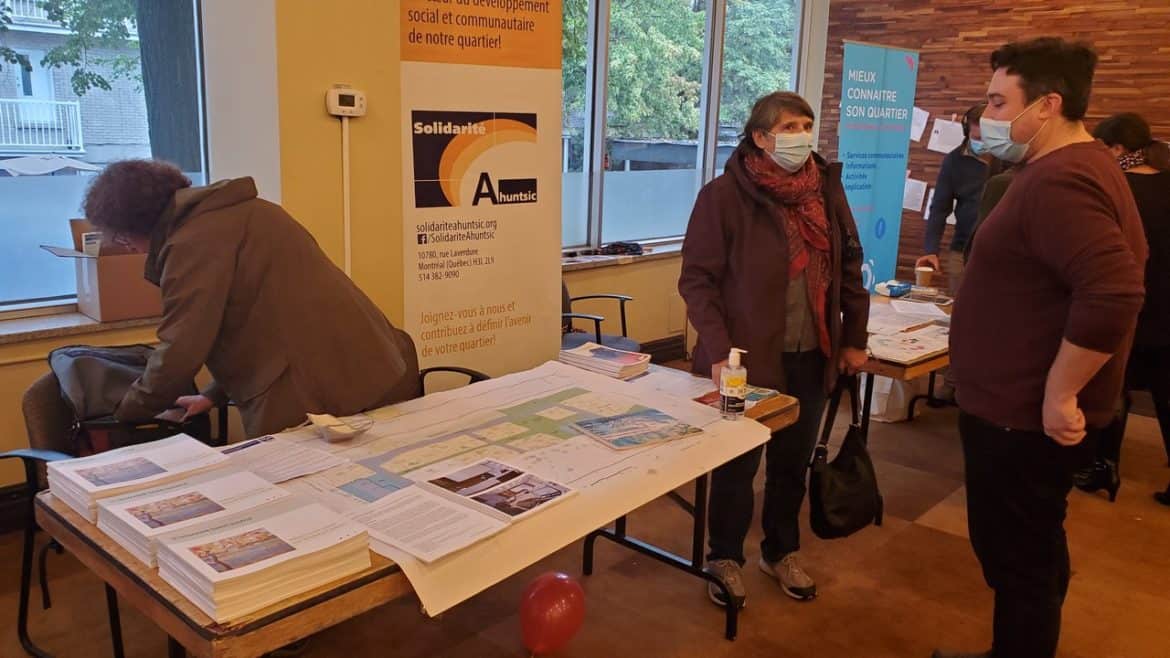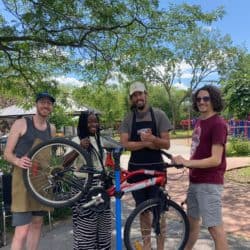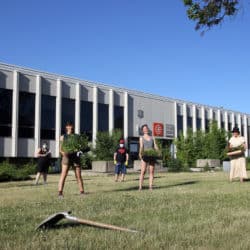The intersectoral and multi-network consultation table focuses on citizens’ quality of life and affordable housing.
Non-profits tackle big problems: poverty; inequities in health, education, and work access; sexual and racial discrimination; refugee crises; food insecurity; community development; et cetera. But a cross-cutting challenge calls for their contribution at another level: the climate crisis. In our Mission Transition series, contributor Diane Bérard examines why non-profits and civil society groups should make the socio-ecological transition a core driver of their strategy, how to do it, and how funders can help. She spoke with seven organizations with very different missions, all contributing to the transition in their own way.
Creating sustainable urban neighbourhoods is a critical part of a successful transition. In our fifth Mission Transition profile, we look at Solidarité Ahuntsic, an intersectoral and multi-network consultation table that focuses on citizens’ quality of life and affordable housing.
Solidarité Ahuntsic (Montreal)
Ghislaine Raymond, citizen, and president of écoquartier Louvain Est’s steering committee
Mission: to co-create a new neighbourhood where life will be suitable for all
What is Solidarité Ahuntsic?
Ghislaine Raymond: Solidarité Ahuntsic is the intersectoral and multi-network consultation table of the Ahuntsic district in the northern part of Montreal. Its mandate is to bring together the various stakeholders in the community to contribute to social development, fight against poverty and exclusion, improve the quality of life of residents, and promote and support the development of social housing.
Solidarité Ahuntsic works on two major projects. What are they?
GR: The first is the CIP [Collective Impact Project], a United Way creation. Montreal has 17 CIPs; each focuses on improving citizens’ quality of life with tailored neighbourhood initiatives. Solidarité Ahuntsic’s second project is écoquartier [“eco-neighbourhood” in English] Louvain Est. It takes place on land the size of seven football fields where the municipal pound used to be. Unfortunately, it has been fallow for several years. This is an essential issue for our community since this development project will considerably modify the district landscape. Moreover, it is one of the only properties belonging to the City of Montreal available for development in north Montreal. Therefore, we have to deploy it responsibly.
How long have you lived in this neighbourhood?
GR: I was born in Laval, on the North Shore. Then in 1973, I crossed the Rivière des Prairies bridge to start my adult life in a small Ahuntsic apartment with a few roommates. Next, I moved with my boyfriend to Saint Denis Street. Then we explored another northern neighbourhood, Villeray, for six years. And it has been 35 years since we came back here to raise our family.
When did your civic engagement begin?
GR: I can’t point to a specific date or place. It was a process. I am an “evolutive citizen.” My engagement developed through people, citizens like me, and experts and politicians, who gave me opportunities to learn and act. For instance, as a teacher in a mixed neighbourhood, I got introduced to socio-economic issues like housing and access to culture through conversations with parents. Over the years, I got involved in matters like fiscal paradises [countries with very low or no taxation that offer tax havens and financial secrecy for foreigners], international solidarity, and free trade. My engagement with the Solidarité Ahuntsic steering committee is about affordable housing.
Tell us about the roots of écoquartier Louvain Est …
GR: This project has been incubated since 2007. For 10 years, Solidarité Ahuntsic and three non-profits met with many borough representatives to claim redevelopment of the site of the former municipal pound on rue de Louvain. The main request concerned social and affordable housing. Ahuntsic’s aging citizens were ready to move into smaller homes, creating possibilities for new families. But lack of adequate housing solutions created a deadlock. At first, the strategy was more aggressive: “You have the land, we have the project, give us the land!” It did not work. In 2018/2019, the dossier got a second life. Public assemblies, information sessions, and 348 hours of citizens’ workshops produced the community’s guiding principles for Louvain Est redeployment.
What was the tipping point of the project?
GR: There is no magic; grassroots work takes time. I was a grandmother when the project finally got the attention it deserved! But we can say that the March 6, 2019, announcement was a milestone for us. That day, Émilie Thuillier, mayor of Ahuntsic-Cartierville, and Éric Alan Caldwell, responsible for urban planning to the executive committee of the City of Montreal, launched a unique partnership between the city and Solidarité Ahuntsic: a shared project office for the Louvain Est site. This office formed two committees: one for coordination and one for governance. I am president of the coordination committee. We have eight members – six citizens, one representative of the Centre intégré universitaire de santé et services sociaux du Nord-de-l’Île-de-Montréal, Solidarité Ahuntsic’s general manager – and a coordinator.
“Eco-neighbourhood” sounds like a trendy real estate concept. But how will it benefit citizens?
GR: We call it an eco-neighbourhood because it will be green, diverse, and on a human scale. It will be anything but trendy. We aim for a governance structure that stands the test of time: the social utility trust (SUF). A SUF is a property without an owner, a property assigned to a vocation rather than for the benefit of a person or an organization. It ensures that a property could never have an owner again. This assignment implies the establishment of governance that will be dedicated to the chosen social utility. It represents an extraordinary potential for the preservation and civic reappropriation of the environment, like turning a vacant pound into an eco-neighbourhood.
What is your Solidarité Ahuntsic vision for the eco-neighbourhood?
GR: We envision between 800 and 1,000 units, with much subsidized housing and affordable housing. The ultimate goal is the sustainable affordability of those units with the social utility trust.
What is the alternative if the social utility trust does not happen?
GR: The land will be divided into lots and sold to developers who will deploy traditional real estate.

Why is this project important?
GR: It is essential because it is a “demand pull” project [i.e., arising from market demand] and not “demand push” [a developer decided it would be good business to build it] with more than 10 non-profits working on it. It is no flavour of the month. But it is what our community needs; citizens are the beating heart of this project.
This project rallies the private sector as well as the academic sector. How do these stakeholders show their support?
GR: Every two weeks, three members of the steering committee work on the eco-neighbourhood project during their workday. Giving employees paid time off is an explicit endorsement of our project from the private sector. We also have the support of Collège Ahuntsic, the borough’s foremost educational institution. The general manager, Nathalie Vallée, participated in the workshops, and she is exploring how eco-neighbourhood Louvain Est could be a laboratory for Collège Ahuntsic students and professors.
How does your project contribute to the transition?
GR: Our project contributes through human apprenticeship: citizens and experts build, step by step, a neighbourhood where life will be suitable for all. We work on housing, food autonomy, active transportation, and energy. In addition, we plan for an integrated thermal network. The timeframe is 10 years; in 2023, we start the demolition of the remaining buildings, and in 2024 we build!
What role do you see for the philanthropic sector in grassroots movements for the transition?
GR: Citizens’ initiatives take time; we need patient capital while organizing and rallying support. And citizens innovate; therefore, we need funding while we experiment. Take the social utility trust: foundations can finance the experts who will advise and support us. The same goes for the integrated thermal network we envision: foundations can finance the feasibility studies. And last but not least, citizens’ initiatives need money until they generate revenues. The 2023 to 2026 period will be cost-intensive for us, with construction everywhere and no gains yet to compensate.
What is the domino effect of grassroots movements?
GR: It is the solidarity-induced learning curve. Other movements give you the energy and ideas to move forward. Our meeting with From the Ground Up in 2018 is a good example. Like us, they are mobilized around issues of community control of land, housing, and the economy, and they seek solutions in the process of participatory democracy.

